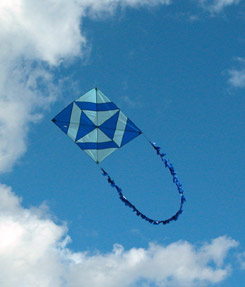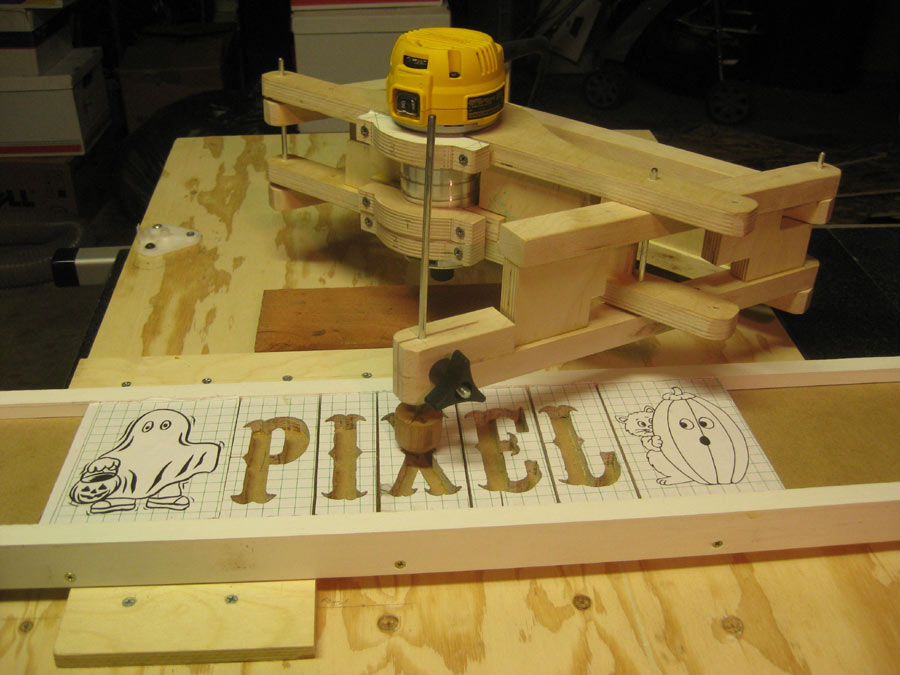Kites I have built
Rokkaku:
This six sided kite has historical beginnings in Sanjo, Japan about 250 years ago.
Rokkakus are generally built by the ratio of “height” to “width” to
“distance between the cross spars”. Two ratios can be used: 6:5:4 or
5:4:3. They are used for “kite combat” and often are 1.8 to 2 meters in
height. Pictured: height 2 meters.
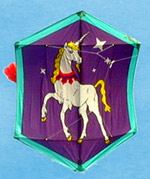
Custom Rokkaku:
This is a four foot “Rok” which I built for an event at work. A tail is not commonly used for rokkaku kites. This is because some degree of instability in flight is desirable for kite battles. A stable rokkaku can be made by adjusting the bridles for Angle of attack, or by adding a tail to the kite which causes it to remain more upright in the sky, and reduces the chances it would overfly the kite handler.
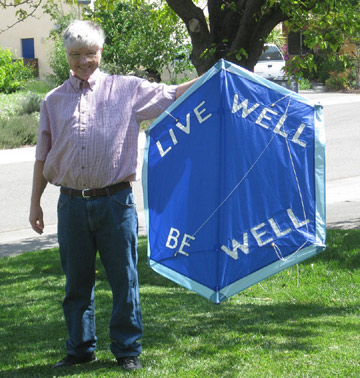
Custom Rokkaku:
When flying a kite of this size or larger, it is important to observe safety measures.
Wear leather gloves. The string can cause nasty cuts or burns. You
cannot control a runaway kiteline with bare hands without injury.
Use a decent kite kite line spool. Rokkakus often use specially designed
kite spools. Pictured is a custom made spool I use for KAP (kite aerial
photography.)
The most common injury suffered while kite flying is a sun burn. Wear sun screen and bring sun glasses. Wear good shoes.
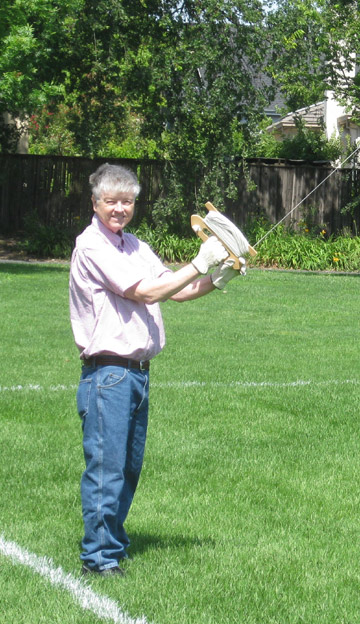
Custom Rokkaku:
The kite line bends slightly due to the “weight” of the kite line.
The kite will fly best with a bit of line out, and not too well with a
short segment of line out.
I suggest letting out about 75 to 100 feet of line with the kite on the
ground. Have an assistant hold the kite while the kite pilot holds the
spool in gloved hands. Take the slack out of the line and have the
assistant gently release the kite when the breeze picks up.
The kite should ascend rapidly and remain stable in the sky. These kites
usually sway gently from one side to another. If it constantly dips to
one side, the bridle needs adjustment. If the kite will not fly, check
sail tension, bowline tension. and or angle of attack. The bottom bow
needs to be “more bowed” than the top bow.
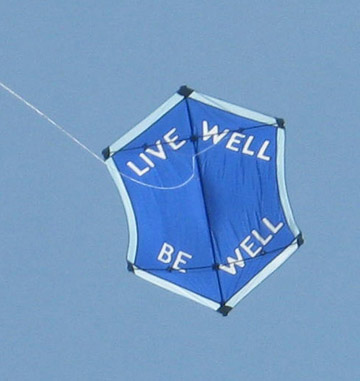
Waco:
The WACO kite was designed by Frenchman Christian Becot. He sent me the plans after our meeting in Asilomar, CA. The kite is designed for use in Kite Aerial Photography. It flies in a wide range of wind speeds, and easily stows to a 1 meter long roll for transport. Wingspan pictured 3 meters.The use of the kite as an adjunct to meteorological experiment was first extensively developed by the British meteorologist E. D. Archibald in 1833. He succeeded in lifting anemometers on kites, measuring wind speeds at various attitudes. As well as reviving the application of the kite as a meteorological tool. Archibald scored a first in 1887 by taking the first aerial photographs from a kite.
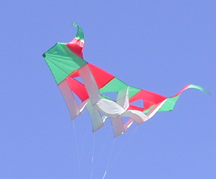
Duck:
This is not a kite per se. It is often referred to as line laundry or line junk. The duck is attached to the kite line below the kite. It is somewhat of a flying wind sock. Length 1.5 meters.

Flow Form:
I built this kite from discussions and plans developed by Harold Prinzler. This kite has no spars, and is made solely of fabric. Thus it is an inflatable kite. The upper contour is that of a wing. It is ideal for Kite Aerial Photography or lifting. The area of this kite is about 36 sq. feet.
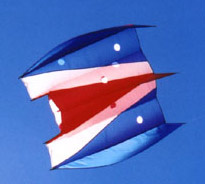
Eddy and Delta kite take teddy up for a jump!
The yellow and red kite is a Delta Conyne, a triangular box kite forms the center. It has a 7 foot wing span. The lower kite is a modified Eddy kite. The kite climbs the delta kite line and on command, releases the paratrooper. The sail of the Eddy then collabses allowing it to descend the line to be used again for the next drop.
Geronimo!
This is the paratrooping teddy after release from the kite.
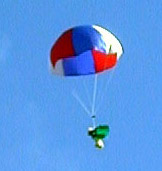
Dopero
(Double Peirson Roller) is being used to support the spinning Catherine’s Wheel. The Dopero is a good lifting kite suitable for Kite Aerial Photography. Throughout the 1890s numerous experiments concerning aerial photography were made on both sides of the Atlantic. Despite E. D. Archibald’s success in 1887, a number of other claims for this `first’ were still appearing during the following decade. In his remarkable work Parakites, Gilbert Totter Woglom states his claim as having made the first aerial photographs to appear in America.
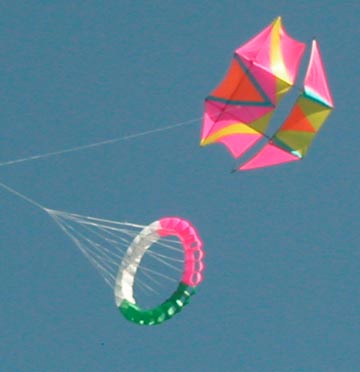
Della Porta Kite.
Giambattista della Porta described a ‘flying sayle’ in his Magiae Naturalis of 1589, a simple though very beautiful rectangular kite, apparently based on the traditional Chinese form. He advocated that the kite be used for lifting fireworks, lanterns at night, and even kittens and puppies. The latter he suggested might be a spur to the idea of human flight. An illustration in John Bate’s The Mystery’s of Nature and Art of 1634 is by way of a diagram, showing a lozenge kite lifting a tail liberally spiked with `fire crackers… which will give divers blower in the ayre’. This diagram is held to be the first illustration of the conventional kite ever to be published in England, and only the second to appear in Europe. The first appeared in 1618 in an engraving of Middelburg, Holland, giving further support to the idea that Dutch merchants played a large role in introducing the kite into Europe. By the seventeenth century the kite had become quite commonplace throughout Europe, though apart from its occasional use in firework displays and various public spectacles it was mainly seen then, as now, as no more than a harmless diversion for children.
